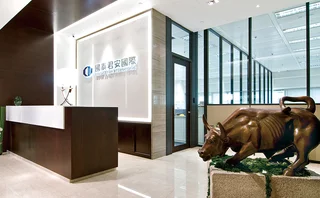
Where’s the silver lining?
To some extent, the collapse of US energy company Enron at the end of last year set the tone for the financial markets in 2002. Bankers have had to negotiate the fallout from corporate America’s largest default, and in particular the highly publicised accounting malpractices exposed at Enron and a handful of other firms in the US and Europe.
These revelations have severely rattled investor confidence. Derivatives structures such as share option schemes have come under the microscope in the US, credit spreads on US and European corporates have soared, and equity markets across the globe have plummeted. While no Asian company was directly implicated in the accounting scandals, the region has not escaped the rout. In Hong Kong, the Hang Seng Index has fallen by more than 12% over the year, while Japan’s Nikkei 225 stock index has been hovering at 19-year lows for most of the fourth quarter. Consequently, banks across the region have been cutting staff and consolidating their operations.
Partly in response to falling stock markets and a related drop off in corporate finance transactions, a number of banks, such as Credit Suisse First Boston, JP Morgan Chase and Salomon Smith Barney, have integrated equity derivatives capabilities within their equity capital markets (ECM) divisions. The restructuring is aimed at opening up new avenues of business for both ECM and equity derivatives by enabling the combined group to offer a wider array of products to corporate treasuries. With some regulators around the region putting pressure on banks and corporates to slash the cross-shareholdings on their balance sheets, bankers hope that this operating structure will stand them in good stead in 2003 (see pages 14–15).
In South Korea, however, it’s been a difficult year for foreign and domestic banks alike. The surge in structured notes in the first half of the year – many of which linked to constant maturity Treasuries – went down a storm with local investors, eager for yield enhancement. But with few hedging alternatives available, banks turned to the swaps market to hedge the deals. As more and more banks streamed into the swaps market, all taking the same position, the swaps curve was forced below the government yield curve leaving a number of financial institutions with sizeable losses .
But it’s not all bad news. As our annual interbank poll shows, the Asian derivatives market continues to develop, with more products available in a growing number of local currencies. This year’s poll comprises 85 categories, up from last year’s 72. As liquidity in these derivatives products grows, end-users are increasingly able to make use of innovative structures to hedge their positions and reduce the cost of funding.
Only users who have a paid subscription or are part of a corporate subscription are able to print or copy content.
To access these options, along with all other subscription benefits, please contact info@risk.net or view our subscription options here: http://subscriptions.risk.net/subscribe
You are currently unable to print this content. Please contact info@risk.net to find out more.
You are currently unable to copy this content. Please contact info@risk.net to find out more.
Copyright Infopro Digital Limited. All rights reserved.
You may share this content using our article tools. Printing this content is for the sole use of the Authorised User (named subscriber), as outlined in our terms and conditions - https://www.infopro-insight.com/terms-conditions/insight-subscriptions/
If you would like to purchase additional rights please email info@risk.net
Copyright Infopro Digital Limited. All rights reserved.
You may share this content using our article tools. Copying this content is for the sole use of the Authorised User (named subscriber), as outlined in our terms and conditions - https://www.infopro-insight.com/terms-conditions/insight-subscriptions/
If you would like to purchase additional rights please email info@risk.net
More on Structured products
A guide to home equity investments: the untapped real estate asset class
This report covers the investment opportunity in untapped home equity and the growth of HEIs, and outlines why the current macroeconomic environment presents a unique inflection point for credit-oriented investors to invest in HEIs
Podcast: Claudio Albanese on how bad models survive
Darwin’s theory of natural selection could help quants detect flawed models and strategies
Range accruals under spotlight as Taiwan prepares for FRTB
Taiwanese banks review viability of products offering options on long-dated rates
Structured products gain favour among Chinese enterprises
The Chinese government’s flagship national strategy for the advancement of regional connectivity – the Belt and Road Initiative – continues to encourage the outward expansion of Chinese state-owned enterprises (SOEs). Here, Guotai Junan International…
Structured notes – Transforming risk into opportunities
Global markets have experienced a period of extreme volatility in response to acute concerns over the economic impact of the Covid‑19 pandemic. Numerix explores what this means for traders, issuers, risk managers and investors as the structured products…
Structured products – Transforming risk into opportunities
The structured product market is one of the most dynamic and complex of all, offering a multitude of benefits to investors. But increased regulation, intense competition and heightened volatility have become the new normal in financial markets, creating…
Increased adoption and innovation are driving the structured products market
To help better understand the challenges and opportunities a range of firms face when operating in this business, the current trends and future of structured products, and how the digital evolution is impacting the market, Numerix’s Ilja Faerman, senior…
Structured products – The ART of risk transfer
Exploring the risk thrown up by autocallables has created a new family of structured products, offering diversification to investors while allowing their manufacturers room to extend their portfolios, writes Manvir Nijhar, co-head of equities and equity…
Most read
- Top 10 operational risks for 2024
- Japanese megabanks shun internal models as FRTB bites
- LCH issued highest cash call in more than five years







